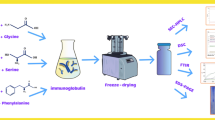Abstract
The influence of lyophilization on the stability of a monoclonal antibody (MN12) was investigated. MN12 was freeze-dried in different formulations [without lyoprotectant or in the presence of sucrose, dextran, or hydroxypropyl-β-cyclodextrin (HPβCD)] and under varying conditions (with or without secondary drying). Subsequently, the monoclonal antibody was stored for 18 or 32 days at various temperatures (4, 37, or 56°C). For comparison, solutions of MN12 were stored under the same conditions. Regardless of the lyoprotectant used, precipitation and a concomitant reduction of the antigen-binding capacity by about 10% were observed upon recon-stitution of lyophilized MN12. HPβCD proved to be the most effective stabilizer to prevent degradation of lyophilized MN12 during storage. Compared with MN12 solutions, HPβCD-containing lyophilized MN12 cakes were more resistant to heat-induced charge alterations and loss of antigen-binding capacity.
Similar content being viewed by others
REFERENCES
M. C. Manning, K. Patel, and R. T. Borchardt. Stability of protein Pharmaceuticals. Pharm. Res. 6:903–918 (1989).
W. Jiskoot, E. C. Beuvery, A. A. M. de Koning, J. N. Herron, and D. J. A. Crommelin. Analytical approaches to the study of monoclonal antibody stability. Pharm. Res. 7:1234–1241 (1990).
M. W. Townsend, P. R. Byron, and P. P. DeLuca. The effects of formulation additives on the degradation of freeze-dried ribonuclease A. Pharm. Res. 7:1086–1091 (1990).
M. W. Townsend and P. P. DeLuca. Nature of aggregates formed during storage of freeze-dried ribonuclease A. J. Pharm. Sci. 80:63–66 (1991).
R. Sherwood. Therapeutic proteins: the need for analysis. Trends Biotechnol. 6:135–136 (1988).
C. Bruck, D. Portetelle, C. Glineur, and A. Bollen. One-step purification of mouse monoclonal antibodies from ascitic fluid by DEAE affi-gel blue chromatography. J. Immunol. Methods 53:313–319 (1982).
P. A. Underwood and P. A. Bean. The influence of methods of production, purification and storage of monoclonal antibodies upon their observed specificities. J. Immunol. Methods 80:189–197 (1985).
S. A. Duffy, B. J. Moellering, G. M. Prior, K. R. Doyle, and C. P. Prior. Recovery of therapeutic-grade antibodies: Protein A and ion-exchange chromatography. BioPharm 2:34–47 (1989).
B. J. Moellering, J. L. Tedesco, R. R. Townsend, and M. R. Hardy. Electrophoretic differences in a MAb expressed in three media. BioPharm 3(2):30–38 (1990).
M. J. Pikal. Freeze-drying of proteins. I. Process design. BioPharm 3(8):18–27 (1990).
T. I. Pŕistoupil, M. ramlová, H. Fo{ie270-1}tová, and S. Ulych. Haemoglobin lyophilized with sucrose: The effect of residual moisture on storage. Haematologia 18:45–52 (1985).
F. Franks. Freeze drying: From empiricism to predictability. CryoLetters 11:93–110 (1990).
M. J. Pikal. Freeze-drying of proteins. II. Formulation selection. BioPharm 3(9):26–30 (1990).
W. Jiskoot, J. J. C. C. van Hertrooij, A.-M. V. Hoven, J. W. T. M. Klein Gebbinck, T. van der Velden-de Groot, D. J. A. Crommelin, and E. C. Beuvery. Preparation of clinical grade monoclonal antibodies from serum-containing cell culture supernatants. J. Immunol. Methods 138:273–283 (1991).
W. Jiskoot, J. J. C. C. Van Hertrooij, J. W. T. M. Klein Gebbinck, T. Van der Velden-de Groot, D. J. A. Crommelin, and E. C. Beuvery. Two-step purification of a murine monoclonal antibody intended for therapeutic application in man. Optimisation of purification conditions and scaling up. J. Immunol. Methods 124:143–156 (1989).
K. Hellman, D. S. Miller, and K. A. Cammack. The effect of freeze-drying on the quaternary structure of L-asparaginase from Erwinia Carotovora. Biochim. Biophys. Acta 743:133–142 (1983).
J. F. Carpenter, L. M. Crowe, and J. H. Crowe. Stabilization of phosphofructokinase with sugars during freeze-drying: Characterization of enhanced protection in the presence of divalent cations. Biochim. Biophys. Acta 923:109–115 (1987).
M. W. Townsend and P. P. DeLuca. Use of lyoprotectants in the freeze-drying of a model protein, ribonuclease A. J. Parent. Sci. Technol. 42:190–199 (1988).
M. E. Brewster, J. W. Simpkins, M. S. Hora, W. C. Stern, and N. Bodor. The potential use of cyclodextrins in parenteral formulations. J. Parent. Sci. Technol. 43:231–240 (1989).
H. Levine and L. Slade. Principles of “cryostabilization” technology from structure/property relationships of carbohydrate/water systems. CryoLetters 9:21–63 (1988).
J. Pitha, J. Milecki, H. Fales, L. Pannell, and K. Uekama. Hydroxypropyl-β-cyclodextrin: Preparation and characterization: effects on solubility of drugs. Int. J. Pharm. 29:73–82 (1986).
D. Duchêne and D. Wouessidjewe. Physicochemical characteristics and pharmaceutical uses of cyclodextrin derivatives. I. Pharm. Technol. 14(6):26–34 (1990).
J. Szjetli. Cyclodextrins in drug formulations. I. Pharm. Technol. Int. 3(2):15–22 (1991).
E. B. Seligmann, Jr. and J. F. Farber. Freeze drying and residual moisture. Cryobiology 8:138–144 (1971).
M. Le Meste, D. Simatos, J. M. Préaud, and P. M. recausta. Factors influencing changes in moisture content during storage of freeze-dried vaccines in vials. J. Biol. Stand. 13:177–184 (1985).
Author information
Authors and Affiliations
Rights and permissions
About this article
Cite this article
Ressing, M.E., Jiskoot, W., Talsma, H. et al. The Influence of Sucrose, Dextran, and Hydroxypropyl-β-cyclodextrin as Lyoprotectants for a Freeze-Dried Mouse IgG2a Monoclonal Antibody (MN12). Pharm Res 9, 266–270 (1992). https://doi.org/10.1023/A:1018905927544
Issue Date:
DOI: https://doi.org/10.1023/A:1018905927544




